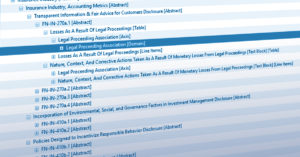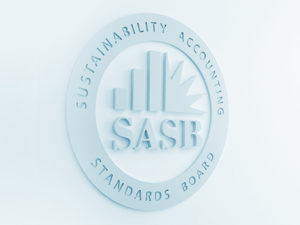Authored by Rebecca Bar, Membership & Engagement Manager at SASB
On February 23rd, SASB cut the ribbon on our new quarterly event series for SASB Alliance members: the Uses of ESG Workshop. This inaugural virtual event, called “Enhancing Approaches to Data and Risk Management Through the SASB Standards,” balanced three expert presentations with collaborative practitioner dialogue. Speakers focused on topics including data use in ESG integration, current data management practices, sustainability-informed portfolio construction, and the role SASB Standards play across each. After each presentation, attendees (primarily practitioners across corporate reporting and investment analysis) broke out into smaller groups to discuss each topic as it applies to their own work.
The Uses of ESG Data and the Prudence of a “Mosaic” Approach
Alliance members first heard from Jeff Cohen, CAIA and SASB’s Director of Capital Markets Integration, who spoke about how ESG data disclosed by companies feeds ESG integration at multiple investment levels. Jeff provided an overview of the role ESG data plays at the research level, the security level, and the portfolio level—recognizing the range of ESG integration strategies and how the SASB Standards enhance analysis. For example, many organisations, including third-party data providers that integrate SASB Standards, tie red-flag indicators to material SASB disclosure topics to monitor portfolio companies. At the security level, analysts adjust valuation model variables, particularly those tied to discount rate assumptions, for the expected impact of specific sustainability factors disclosed using the SASB Standards.
Jeff also discussed the critical role that third-party data providers play in growing the state of company-disclosed ESG data and supporting effective ESG integration, touching on the challenges investors face when interpreting information from different providers. For example, third-party providers often rank companies using methodologies with significant differences in the scope of ESG topics and the way those topics are measured, leading to high levels of variance in ESG assessments. Investors therefore approach ESG analysis using third-party data with a certain level of scrutiny. This is not an inherently bad thing, as greater scrutiny can lead to richer analysis. Yet, very real quantitative challenges, such as measurement divergence across the same ESG topics and different distributions among ESG metrics, can limit and skew analysis.
Given the relatively nascent and increasingly diverse state of ESG data, Jeff suggests that a “mosaic” approach to data sourcing with a SASB lens can support ESG integration efforts. Practitioners can source a vast range of ESG data—combining company-disclosed data, data providers’ scores, and unstructured data aggregated by other providers—to gain a strong ESG perspective. The SASB Standards can be applied to these data sources (individually or in aggregate) to identify financially material information and reduce the scoping challenge that, in part, leads to correlation variance. Ultimately, investors can (and do) use SASB Standards to navigate existing data challenges and source decision-useful ESG information for many levels of ESG integration.
SASB Mapping Overview: Working Toward Common Data Architecture
Next, we heard from SASB’s Director of Partnerships and Market Outreach, Nicolai Lundy. Nicolai shared forward-looking observations on ESG data management practices and explained how third-party providers use the information architecture of the SASB Standards to structure the data behind their products.
Related to the “mosaic” approach to data sourcing described by Jeff, Nicolai discussed the growing practice of “data lakes.” Today, institutional investors must reconcile highly variable ESG datasets and products with a wide range of needs. By aggregating multiple inputs into a “lake” using a core data architecture (such as that provided by the SASB Standards), investors can better organize data to meet distinct needs (such as assessing risk and upside potential, client reporting, or regulatory compliance) rather than organizing and segmenting data separately for particular needs or use cases.
However, the onus of culling ESG data by applying a sustainability-focused architecture does not fall solely on the practitioner. Some data providers such as Arabesque S-Ray, S-Factor, Truvalue Labs and others use the SASB Standards as core information architecture to build their data products. Other providers such as Bloomberg, ISS-ESG, MSCI, Refinitiv, and Sustainalytics overlay or “map” the SASB Standards to their existing data taxonomies rather than integrating SASB Standards into the data collection and categorization process.
To illustrate how these mapping efforts are designed to be useful for practitioners, Nicolai used an example with another mapping—the SASB Standards mapped to the UN Sustainable Development Goals (SDGs). The map identifies which SASB disclosure topics link to specific SDG targets, making it easier for practitioners to determine which SDGs are most relevant to the financial condition and operating performance of their business. As the SASB Standards continue to be integrated and mapped to datasets across the market, investors can pair insights from third-party data providers with SASB disclosure topics all in one place.
Investment Taxonomies and Portfolio Management: GICS v. SICS®
Finally, workshop attendees heard from Decio Nascimento, Guest Lecturer at the Yale School of Management and Founder and Chief Investment Officer of Norbury Partners. Decio discussed the benefits of integrating sustainability factors into portfolio allocation and presented the research findings of his 2018 paper, which explores application-based differences in the traditional industry classification system, GICS, and SASB’s Sustainable Industry Classification System® (SICS®).
Among other insights, Decio’s discussion and research highlight a few truths that can help investors improve portfolio diversification. First, he demonstrated the ability of SICS® to help investors see certain portfolio-level risks. For example, if one were to look at a portfolio containing companies in the chemicals, apparel, and beverage industries, one might feel comfortable with the level of diversification according to GICS. However, if these companies operate in an area experiencing water shortages, as was the case in South Africa in 2018, SICS® reveals that each of these companies face a level of underlying risk due to their high reliance on water as a key input. In other words, it exposes industries in different sectors that are subject to the same ESG risk factor—revealing where the diversification, or levels of between-industry correlation, identified by GICS may not be as favourable as originally thought.
His research also demonstrates the correlation benefits of using GICS and SICS® together. Interestingly, if one were to diversify a portfolio using only GICS or only SICS® in isolation, they would achieve comparable results (though GICS performs slightly higher). However, if you combine the two classification systems, one can materially improve correlation and ultimately have a classification system that is superior to the results achieved if using any one individually.
Practitioner-to-Practitioner: An Open Dialogue Among Corporates and Investors
During and between each presentation, workshop attendees not only had the opportunity to ask questions directly to our expert presenters, but also gained valuable insight from each other.
We intermittently gathered polling insights throughout the workshop, allowing attendees to see in real time the extent to which others in the workshop rely on third-party ESG ratings (82% do), which data providers they use (MSCI, Sustainalytics, and ISS-ESG were the top three), and the extent to which others are already or actively considering multiple ESG data inputs as part of their integration strategy (71% do), among other polling questions administered.
After each presentation, attendees broke out into smaller groups to network and take part in spirited practitioner discussion. Under Chatham House Rule, Alliance members shared their ideas and experiences related to ESG integration, data sourcing, and SASB Standards in application.
The Next Workshop
The Uses of ESG Workshop was developed in response to Alliance member feedback and will continue to be shaped by feedback going forward. We are excited to continue to host this interactive event in quarters to come.
The next workshop will take place on April 8. It will build upon Jeff Cohen’s paper, “Integrating ESG Holistically in Private Equity: A Strategic Approach.” During the workshop, we will explore SASB’s recent work to practically address ESG challenges in private markets and hear nuanced perspectives from limited partners’ academic work and direct experience.
For more information about the April 8 workshop and to express your interest in attending, please follow this link. As an interactive event, attendees are expected to participate in facilitated discussions following each brief speaker presentation. For more information about the SASB Alliance, please contact Victoria Reyes.

